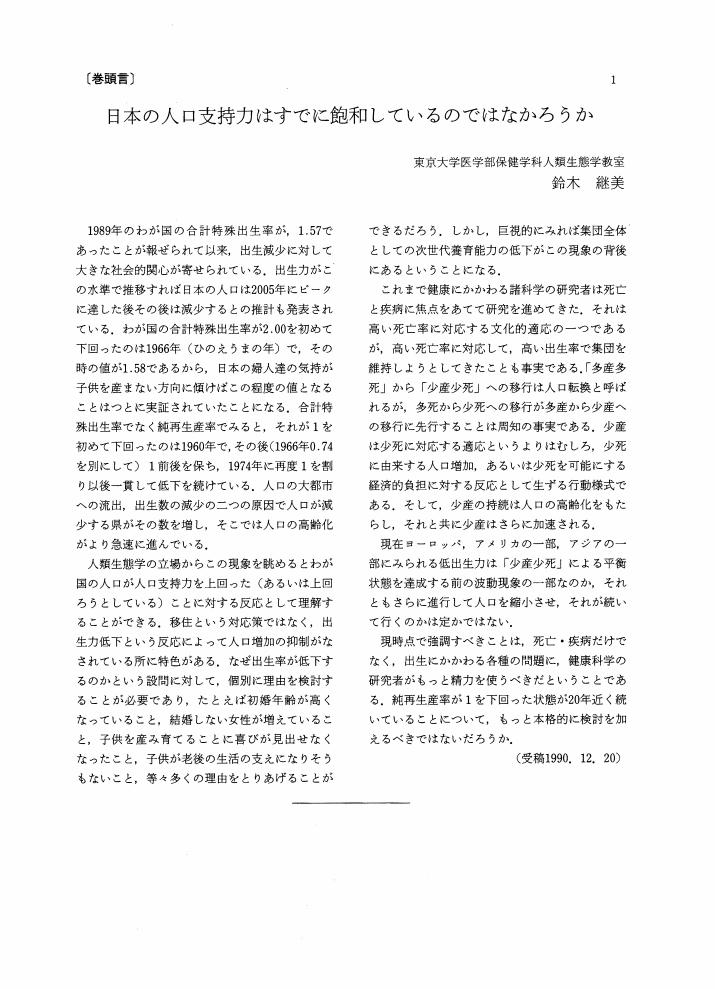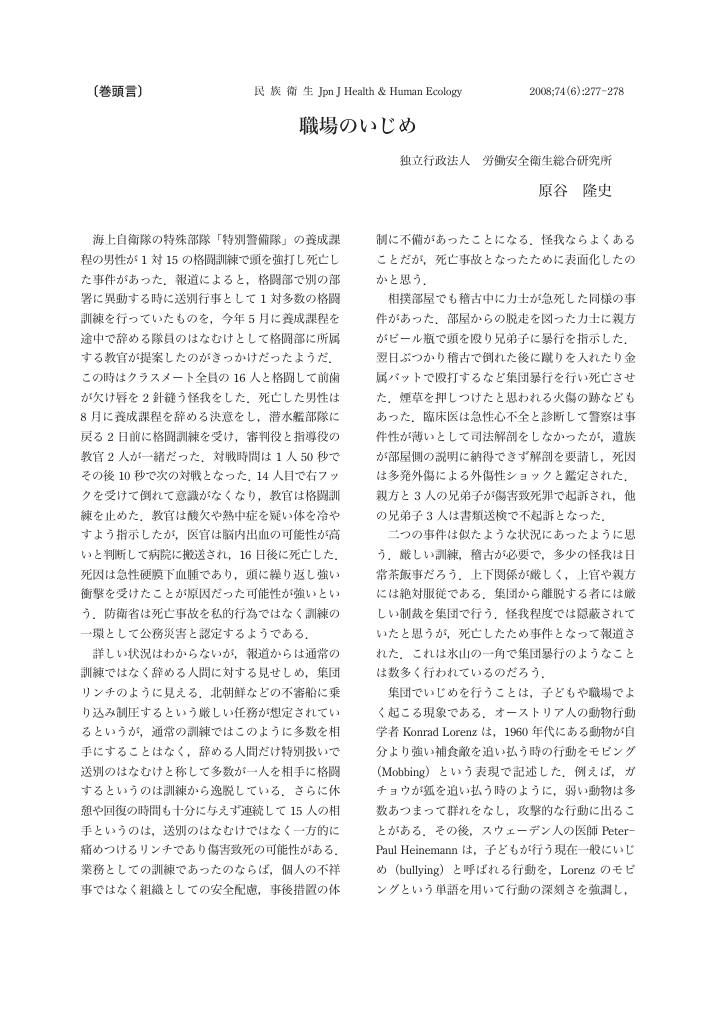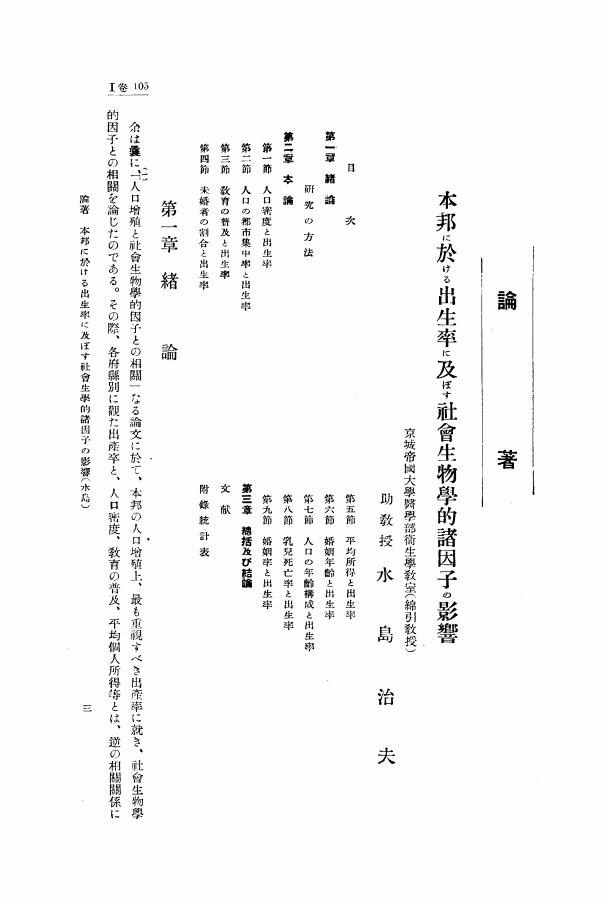4 0 0 0 OA 「おむつなし育児」をすると子どものおむつは早く外れるのか?
- 著者
- 須藤 茉衣子 笹川 恵美 吉朝 加奈 松崎 良美 松本 亜紀 三砂 ちづる
- 出版者
- 日本民族衛生学会
- 雑誌
- 民族衛生 (ISSN:03689395)
- 巻号頁・発行日
- vol.82, no.4, pp.156-165, 2016-07-31 (Released:2016-08-29)
- 参考文献数
- 13
Objective:We investigated at which age children who started caregiver-assisted toilet training (diaperless child care) under age 1 stopped needing diapers.Methods:We conducted a cross-sectional study using a self-administered mailed questionnaire in Tokyo be tween April and May 2012. The participants were mothers who started toilet training their children under age 1. At the time of the study, the children had to be ≥2 years old. Questionnaires were dis tributed to 175 mothers, and data from 125 were analyzed.Results:A total of 116 (92.8%) children stopped needing diapers during the day, and the mean age of the chil dren who did not rely on diapers was 21 months. Mean age did not significantly differ by characteris tics such as childʼs or the motherʼs age, family structure, or employment situation. However, it tend ed to be related to the frequency of using paper diapers and age of starting diaperless childcare.Discussion:An increase in the number of children using diapers at 3 years of age has been reported in recent years. However, the mean age at which children in this study did not rely on diapers during the day was <2 years. Our findings suggest that early caregiver-assisted toilet training can facilitate indepen dent toileting in children.
4 0 0 0 OA 重篤な有害事象報告前後におけるHPVワクチンに対する保護者の認識と要望に関する研究
- 著者
- 石野 晶子
- 出版者
- 日本民族衛生学会
- 雑誌
- 民族衛生 (ISSN:03689395)
- 巻号頁・発行日
- vol.82, no.6, pp.208-216, 2016-11-30 (Released:2016-12-26)
- 参考文献数
- 27
Questionnaires were administered to parents of children eligible to receive the human papillomavirus (HPV) vaccine to assess changes in parents’ awareness of the HPV vaccine and their needs regarding the vaccine after reports of its serious adverse events in the media. Parents lacked sufficient awareness of cervical cancer and no difference in awareness level was seen after the reports. However, a difference was seen in parents’ awareness of HPV vaccination after the reports of adverse events. This is thought to be because parents did not receive consistent information before and after the reports of the adverse events and because they had always been subconsciously concerned about the vaccination, due to a lack of sufficient awareness of the HPV vaccine. In particular, parents’ concern about side effects was the factor accounting for the difference in their awareness regarding HPV vaccination for children. This suggests that it is necessary to establish measures for providing parents with consistent information and knowledge on HPV vaccine.
4 0 0 0 OA 人口構造の変化が感染症の流行に与える影響 : 宮崎県の事例
- 著者
- 竹内 昌平 山内 武紀 黒田 嘉紀
- 出版者
- 日本民族衛生学会
- 雑誌
- 民族衛生 (ISSN:03689395)
- 巻号頁・発行日
- vol.80, no.1, pp.17-22, 2014 (Released:2014-03-28)
- 参考文献数
- 16
- 被引用文献数
- 1
The spread of influenza depends on contact among people. Contact rates are known to vary depending on the combination of age groups, which means that the age structure of a population affects the spread of influenza. We herein report how future changes in the population structure of Miyazaki Prefecture, a rural region in Japan, will affect the potential spread of influenza. We also report the results of an investigation on how future fertility changes will modify the potential spread through changes in the population structure. The basic reproduction number (R0) was used as an indicator of spread. The future population structure was projected by the cohort component method. Age-group-specific contact rates were obtained by a questionnaire survey. We found that the R0 of a new type of influenza will not change over the next 100 years if vital statistics remain constant (Scenario 0). If the total fertility rate increases by 10% or 25% from 1.7 (the level in 2011), the R0 in 2111 will be higher than that in Scenario 0. These results suggest that fertility recovery, an urgent demographic policy target in Japan, has the potential to increase the spread of influenza.
3 0 0 0 OA 日本人と白人及び黒人との混血兒の調査
- 著者
- 窪田 義信
- 出版者
- 日本民族衛生学会
- 雑誌
- 民族衛生 (ISSN:03689395)
- 巻号頁・発行日
- vol.19, no.5-6, pp.93-106,A7, 1953 (Released:2010-11-19)
Studies have been made since 1948 with regard to 201 white American-Japanese and 66 Negro-Japanese hybrids who were found in the vicinity of Tokyo and in the Prefecture of Kanagawa. They were all under 6 years of age, and thier mothers were invariably Japanese.1) Blood type. Of the white American-Japanese hybrids, those having A type blood represent a high percentage (49.5 percent), inasmuch as that blood type accounts for a large majority of both the whites and the Japanese. The figures for B and O types respectively stand about half-way between the corresponding figures for the two races. The average racial index of blood of the white American-Japanese hibrids is 2.93, showing a European type, while the Japanese index stands at 1.53 and always retains the Asian type. a The racial serologic point of the hybrids, as Figure No. 1. shows, stands at about the middle between the two races, though slightly trending to the left -side. (Table 1)2) Type of finger marks. The Japanese pattern is characterized by a small percentage of arches (1.8 percent) and a large percentage of loops (48 percent). Hybrids show a considerably high percentage of arches (4.9 per cent), which approaches to the figure for the white race (5.2 percent). Similar influence of the when type is also perceived. Likewise the racial pattern index (W/R+U) of the hybrids comes in the neighborhood of the average for the two races, i. e. 77.3, with the Japanese index standing at 85 and the index for the white at 51. As regards proportion of ulnar loops and whorl, the larger per cent of the native Japanese belongs to 5W and a smaller per cent to 5U. These ratio is reversed in the case of Europeans. The hybrids appear to possess mixed traits of both races. The U2W3 accounts for the highest percentage. (Fig. 2) (Table 2, 3)3) Mongolian spot. The percentage of revelition, in the case of hybrids, is one-third of the figure for native Japanese. In the first year after birth, the spot appears highest in 45 per cent of hybrid, as against 99.5 per cent of the native Japanese babies. More notable is the fact that the spot in the case of hybrid babies is of lighter color, smaller in size and, as shown in Tables No. 3, 4, Fig. 3, disappears sooner, generally by the age of 4.4) Color of skin. By comparison with the Hintze's Color Table, we have ascertained that, on the one hand, the skin of American-Japanese hybrids is 13 per cent whiter than that of pure Japanese, but is 2.4 per cent less white than that of the white race, and, on the other, it is 16 per cent less dark than that of pure Japanese, but is 4 per cent darker than that of the white race. Namely in color, it is very near to that of white and is almost devoid of the characteristic yellowish shade. As for Negro-Japanese hybrids, they have a skin intermediate in color between that of the Japanese native and the Negro: (Table 7).5) Color and form of hair. About half (52.2 percent) of American-Japanese hybrids have black hair, and 11 per cent hair of lighter color, mostly brunette rather than blond of the white race. The hair of Negro-Japanese hybrids is mostly black, (86 percent) but it is sometimes blond (6.2 percent). (Table 7)The hair of 60 per cent of American-Japanese hybrids is straight and that of 14 per cent slightly curled. As a whole, their hair is more wavy in form than it is intermediate between the hair forms of the two races, while the Japanese have straight hair with some exception. Of the Negro-Japanese hybrids, 15.8 per cent have straight hair and 38 per cent slightly curled hair form, showing a marked increase in the Japanese form as the result of this race mixture. (Table 8)
3 0 0 0 OA 謝辞の豊かさ
- 著者
- 金城 芳秀
- 出版者
- 日本民族衛生学会
- 雑誌
- 民族衛生 (ISSN:03689395)
- 巻号頁・発行日
- vol.83, no.1, pp.1, 2017-01-31 (Released:2017-02-24)
- 著者
- 魏 燕玲 田中 豊穂
- 出版者
- 日本民族衛生学会
- 雑誌
- 民族衛生 (ISSN:03689395)
- 巻号頁・発行日
- vol.76, no.2, pp.57-68, 2010 (Released:2010-05-31)
- 参考文献数
- 43
The purpose of this research is to compare two different high altitudes Tibetan group’s physiques, physical strengths and physiological functions.In total 199 Tibetan subjects, 101 subjects (48 males and 53 females) from a 1800 meter highlands (mid-altitude group) and 98 subjects (48 males and 50 females) from a 4000 meter highlands (high altitude group) were examined morphological and physiological characteristics such as height, weight, vital capacity, blood pressure, grip strength and two step exercise test. Subjects for the analyses were extracted from the total subjects by matching the age and sex between the two groups, 53 subjects respectively.Compared to the mid-altitude group, the high altitude group had a smaller body size, lower physical abilities except for endurance performance, lower systolic and diastolic blood pressure and lower vital capacity. The results of vital capacity were different from that of previous researches. Although the blood pressure was remarkably low in high altitude group, it is difficult to attribute the cause only to the difference of altitude, because besides the altitude some differences such as occupations and eating habits existed between the comparison groups.
2 0 0 0 OA 会長講演、特別講演I,II 教育講演 抄録
2 0 0 0 OA エイズに学ぶ
- 著者
- 玉城 英彦
- 出版者
- 日本民族衛生学会
- 雑誌
- 民族衛生 (ISSN:03689395)
- 巻号頁・発行日
- vol.76, no.1, pp.1-2, 2010 (Released:2010-03-25)
2 0 0 0 OA 日本の人口支持力はすでに飽和しているのではなかろうか
- 著者
- 鈴木 継美
- 出版者
- 日本民族衛生学会
- 雑誌
- 民族衛生 (ISSN:03689395)
- 巻号頁・発行日
- vol.57, no.1, pp.1, 1991 (Released:2010-06-28)
2 0 0 0 OA 職場のいじめ
- 著者
- 原谷 隆史
- 出版者
- 日本民族衛生学会
- 雑誌
- 民族衛生 (ISSN:03689395)
- 巻号頁・発行日
- vol.74, no.6, pp.277-278, 2008-11-30 (Released:2009-03-13)
2 0 0 0 OA ナチス斷種法に就いての感想
- 著者
- 立石 謙輔
- 出版者
- 日本民族衛生学会
- 雑誌
- 民族衛生 (ISSN:03689395)
- 巻号頁・発行日
- vol.3, no.4-5, pp.311-314, 1934-06-27 (Released:2010-11-19)
2 0 0 0 OA トンガ王国における高い出生率と海外移出率 : MIRAB 社会における人口転換の特徴
- 著者
- 小西 祥子
- 出版者
- 日本民族衛生学会
- 雑誌
- 民族衛生 (ISSN:03689395)
- 巻号頁・発行日
- vol.80, no.1, pp.48-53, 2014 (Released:2014-03-28)
- 参考文献数
- 16
Examples of demographic transition include transitions from high-fertility-high-mortality to high-fertility-low-mortality and to low-fertility-low-mortality. In general, a high population growth rate is observed in the high-fertility-low-mortality phase, and the rate of population growth decreases in the low-fertility-low-mortality phase. Using available demographic data from the Kingdom of Tonga for the years 1891 to 2011, we described the demographic transition pattern in this country. Since 1953, the crude mortality rate has been lower than 10‰, while the crude birth rate remained as high as 27‰ until 2011. Despite the high fertility and low mortality rates from 1996 to 2006, the mean annual population growth rate was only 4.2‰, which is attributable to the net migration rate of-17.8‰. In addition, out-migration of both young and older adults, together with the high fertility rate, contributed to the maintenance of the pyramidal shape of the population age structure of the country from 1956 to 2006. This study shows that this MIRAB (migration, remittance, aid financed, and bureaucracy) society, has been experiencing a unique demographic transition due to a high out-migration rate. Because the international migration rate has been increasing in various regions throughout the world, we may need to re-examine the demographic transition theory while considering the significant effects of international migration.
2 0 0 0 OA 学会名の変更に際して考える
- 著者
- 横山 和仁
- 出版者
- 日本民族衛生学会
- 雑誌
- 民族衛生 (ISSN:03689395)
- 巻号頁・発行日
- vol.82, no.6, pp.207-207, 2016-11-30 (Released:2016-12-26)
2 0 0 0 OA チャールズ・ダーウィンと丸山教授のα-インデックスと △-曲線
- 著者
- 飯淵 康雄
- 出版者
- 日本民族衛生学会
- 雑誌
- 民族衛生 (ISSN:03689395)
- 巻号頁・発行日
- vol.56, no.6, pp.258-291, 1990-11-30 (Released:2011-02-25)
- 参考文献数
- 13
J.Grauntは17世紀に世界で初めて年齢別死亡・生残表の数字を提供した.これを初めてグラフ化した人が丸山博教授だった。又,同教授は第2次大戦前に,B・ピシャー氏の乳児死亡研究より早く,ほぼ同じ思考方法で,α-lndexや△-Curveを創造した.本研究では,これらの研究内容にひそめられた「累加死亡数」という累積的効果の実際的・学問的意味をC.Darwinの著作の中に求め,それらの学問的意味をJ.Grauntや丸山博氏の独創的研究に導入することにより,丸山教授の研究成果が今日でも有効に活用できることを実証した.
2 0 0 0 OA 資料
- 出版者
- 日本民族衛生学会
- 雑誌
- 民族衛生 (ISSN:03689395)
- 巻号頁・発行日
- vol.4, no.3-4, pp.330-337, 1935-07-20 (Released:2010-12-22)
2 0 0 0 OA “岩木健康増進プロジェクト” でいつも考えること
- 著者
- 中路 重之
- 出版者
- 日本民族衛生学会
- 雑誌
- 民族衛生 (ISSN:03689395)
- 巻号頁・発行日
- vol.81, no.1, pp.1-2, 2015 (Released:2015-05-01)
2 0 0 0 OA 外国人看護師受け入れについて思うこと
- 著者
- 北池 正
- 出版者
- 日本民族衛生学会
- 雑誌
- 民族衛生 (ISSN:03689395)
- 巻号頁・発行日
- vol.80, no.2, pp.85-86, 2014 (Released:2014-05-26)
2 0 0 0 OA 葡萄糖による甘さの閾値に就て
- 著者
- 三村 信之
- 出版者
- 日本民族衛生学会
- 雑誌
- 民族衛生 (ISSN:03689395)
- 巻号頁・発行日
- vol.17, no.1, pp.17-19,A1, 1950 (Released:2010-11-19)
- 参考文献数
- 2
The threshold of judgment (Cj) and of perception (Cp), as defined in the author's previous paper, were determined on 30 (26 males and 4 females) Japanese. The frequency distribUtion of the former is represented in Fig I A, and of the latter in Fig 1 13, both irrespective of sex. (Cf. p. 9 and p. 10)
1 0 0 0 OA 第2編 知能及び性格テストに就て
1 0 0 0 OA 本邦に於ける出生率に及ぼす社會生物學的諸因子の影響
- 著者
- 水島 治夫
- 出版者
- 日本民族衛生学会
- 雑誌
- 民族衛生 (ISSN:03689395)
- 巻号頁・発行日
- vol.1, no.2, pp.105-120, 1931-05-23 (Released:2010-11-19)











